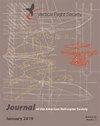高速旋翼机俯仰轴响应类型研究
IF 1.4
4区 工程技术
Q2 ENGINEERING, AEROSPACE
引用次数: 0
摘要
本文系统地研究了高速旋翼机的俯仰轴响应类型、指挥模型和操纵质量规范。该研究使用了两种未来垂直升力相关的旋翼机配置-升力偏移同轴直升机与推进螺旋桨和倾转旋翼。研究了五种响应类型,包括旋翼飞机通常使用的俯仰率-命令/姿态保持响应类型,使用基于传统飞机俯仰率传递函数的高阶命令模型的俯仰率-命令/姿态保持响应类型,普通加速度命令/迎角保持响应类型,航迹率命令/航迹保持响应类型,以及一种“混合”航路速率命令响应类型,该类型根据操纵杆输入大小改变命令模型带宽。在宾夕法尼亚州立大学飞行模拟器设施中,利用两个高速任务单元,对不同水平的俯仰姿态带宽、飞行路径带宽、控制预估参数和俯仰姿态后降设计进行了评估。导航仿真结果表明,俯仰姿态带宽和俯仰姿态回降都必须满足1级操纵质量的要求。附录提供了一套建议的规范和相关的更新级别边界。本文章由计算机程序翻译,如有差异,请以英文原文为准。
High-Speed Rotorcraft Pitch Axis Response Type Investigation
This paper presents a systematic investigation of high-speed rotorcraft pitch-axis response types, command models, and handling qualities specifications. The investigation was done using two future vertical lift-relevant rotorcraft configurations—a lift offset coaxial helicopter with a pusher propeller and a tiltrotor. Five response types were investigated, consisting of a pitch rate-command/attitude-hold response type typically used for rotorcraft, a pitch rate-command/attitude-hold response type using a higher-order command model based on the conventional airplane pitch rate transfer function, a normal acceleration command/angle-of-attack hold response type, a flight path rate command/flight path hold response type, and a "blended" flight path rate command response type which varies the command model bandwidth based on stick input size. Designs of varying levels of pitch attitude bandwidth, flight path bandwidth, control anticipation parameter, and pitch attitude dropback were evaluated in a piloted simulation experiment conducted at the Penn State Flight Simulator facility using two high-speed mission task elements. The results of the piloted simulation suggest that both the pitch attitude bandwidth and the pitch attitude dropback requirements must be met for Level 1 handling qualities. A set of recommended specifications and associated updated level boundaries is provided in the Appendix.
求助全文
通过发布文献求助,成功后即可免费获取论文全文。
去求助
来源期刊

Journal of the American Helicopter Society
工程技术-工程:宇航
CiteScore
4.10
自引率
33.30%
发文量
36
审稿时长
>12 weeks
期刊介绍:
The Journal of the American Helicopter Society is a peer-reviewed technical journal published quarterly (January, April, July and October) by AHS — The Vertical Flight Society. It is the world''s only scientific journal dedicated to vertical flight technology and is available in print and online.
The Journal publishes original technical papers dealing with theory and practice of vertical flight. The Journal seeks to foster the exchange of significant new ideas and information about helicopters and V/STOL aircraft. The scope of the Journal covers the full range of research, analysis, design, manufacturing, test, operations, and support. A constantly growing list of specialty areas is included within that scope. These range from the classical specialties like aerodynamic, dynamics and structures to more recent priorities such as acoustics, materials and signature reduction and to operational issues such as design criteria, safety and reliability. (Note: semi- and nontechnical articles of more general interest reporting current events or experiences should be sent to the VFS magazine
 求助内容:
求助内容: 应助结果提醒方式:
应助结果提醒方式:


